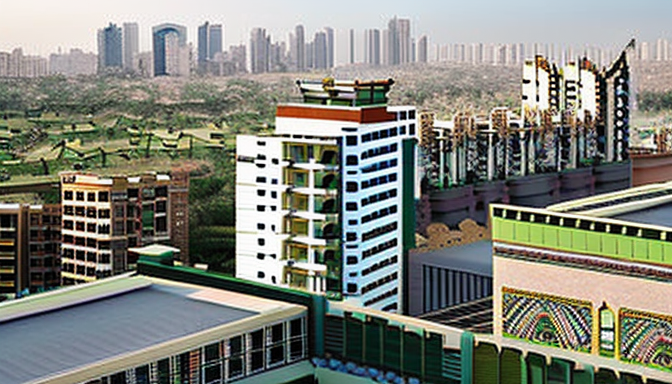Karachi, a city bustling with life, tells a story through its architecture. From the sturdy forts that once guarded its shores to the sleek facades of modern buildings, each structure reflects a piece of the city’s rich history. Let’s take a moment to explore this fascinating journey.
In the early days, Karachi was more than just a port; it was a strategic military hub. The forts of Karachi, like the iconic Manora and the imposing Fort Frere, were built to protect against invasions. These structures are not just stone and mortar; they are a testament to the city’s colonial past. The British, with their distinct architectural styles, left an indelible mark on Karachi’s skyline. Think of it as a patchwork quilt of history, where each fort represents a different era and purpose.
As we moved into the British era, the city saw the rise of colonial architecture. Buildings like the Karachi Port Trust and the Frere Hall showcase Victorian and Gothic influences. These designs were not just about aesthetics; they embodied policies and aspirations of the time. They symbolize a blend of cultures, as local artisans added their unique touch to foreign designs.
Today, as Karachi embraces modernity, we see a shift towards innovative architectural trends. However, the essence of history remains. Contemporary buildings often pay homage to their predecessors, creating a dialogue between the past and the present. The city is evolving, yet it holds onto its roots, reminding us that every facade has a story to tell.
Historical Significance of Karachi’s Forts
The forts of Karachi are not just stone structures; they are living testimonies of the city’s rich and tumultuous history. Built during various eras, these forts reflect the strategic importance of Karachi as a port city. From the early days of the Portuguese and Mughal rule to the British colonial era, each fort tells a story of military needs and architectural evolution.
Take, for example, the iconic Frere Hall, built in the 19th century. This stunning structure showcases the Gothic Revival style that was popular among the British architects of the time. Its intricate details and lush gardens provide a glimpse into the past. But why were these forts so crucial? Well, Karachi’s location made it a vital point for trade and defense.
During the British era, policies were enacted that shaped the urban landscape significantly. The British not only constructed forts but also implemented systems that transformed Karachi into a bustling metropolis. This transformation can be summarized in a few key points:
- Strategic Defense: Forts were built to protect against invasions.
- Trade Facilitation: They served as hubs for commerce.
- Cultural Exchange: Architectural styles blended, enriching the city’s identity.
Today, these forts stand as a reminder of Karachi’s colonial past and the diverse influences that have shaped its skyline. They invite us to explore not just their walls but the stories and cultures embedded within them. Each visit is like peeling back layers of history, revealing the rich tapestry that is Karachi.

Modern Architectural Trends in Karachi
Karachi is a city where the old meets the new. Its skyline is a blend of colonial history and modern innovation. The British-era buildings still stand tall, whispering stories of a time when Karachi was a bustling port city under colonial rule. These structures, with their intricate designs, paved the way for the architectural trends we see today.
But what does modern architecture in Karachi look like? It’s not just about glass and steel. It’s about creativity and sustainability. Architects today are embracing eco-friendly practices. They’re designing buildings that not only look good but also do good for the environment. Think of rooftops covered in greenery or buildings that harness solar energy. This shift is crucial as the city faces urban challenges like overcrowding and pollution.
Let’s take a closer look at some key trends:
- Adaptive Reuse: Old warehouses transformed into trendy cafes.
- Green Buildings: Structures designed to minimize environmental impact.
- Smart Technology: Incorporating tech for better energy efficiency.
These trends reflect a city that is not afraid to evolve. Karachi’s modern architecture is more than just a visual treat; it’s a response to the needs of its people. It’s about creating spaces that are functional, beautiful, and sustainable. As we walk through its streets, we see a city that respects its past while boldly stepping into the future.
Frequently Asked Questions
- What are the most significant forts in Karachi?
The most notable forts in Karachi include the Frere Fort, Manora Fort, and Fort Sandeman. Each of these structures tells a unique story of the city’s past and its strategic military importance.
- How has modern architecture influenced Karachi’s skyline?
Modern architecture in Karachi has introduced innovative designs and sustainable practices, transforming the skyline while respecting historical elements. Buildings like the Dolmen Mall and Karachi Marina showcase this blend of old and new.
- What cultural influences shaped Karachi’s architecture?
Karachi’s architecture is a melting pot of influences, including British colonial, Mughal, and local Sindhi styles. This rich tapestry reflects the city’s diverse history and the various cultures that have left their mark over the years.
- Are there any sustainable architectural practices in Karachi?
Yes! Many modern buildings in Karachi are designed with sustainability in mind, incorporating green roofs, solar energy, and water-efficient systems to reduce their environmental impact.